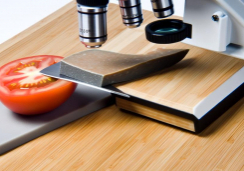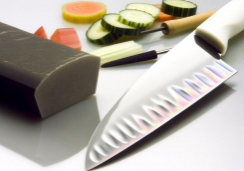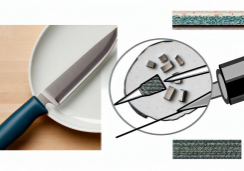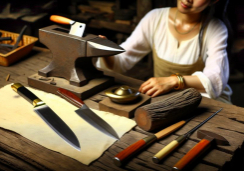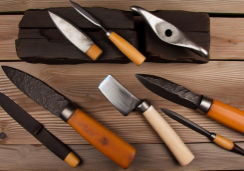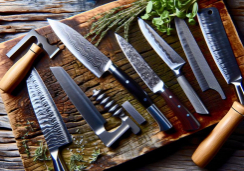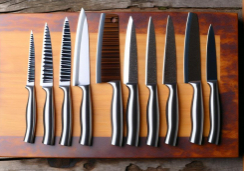Top 10 Steel Varieties for Superior Kitchen Knives
Just as you're sharpening your favorite chef's knife, it might cross your mind: what exactly makes this blade so dependable? You're not alone in pondering the complex world of steel varieties that transform a simple knife into a culinary extension of your own hand.
As a cook, whether amateur or professional, the quality of your tools is non-negotiable, and the heart of your culinary arsenal is undoubtedly the steel of your knives. By understanding the top steel varieties, from the resilient carbon steel to the prestigious Damascus and the cutting-edge VG-10, you'll be equipped to make an informed decision about which steel best suits your kitchen needs.
However, navigating through the nuances of each steel type can be as intricate as executing the perfect julienne, so stick around as we slice through the hype to uncover the steels that promise to elevate your culinary experience.
Carbon Steel Advantages
Carbon steel's inherent resilience offers a significant advantage for kitchen knives, providing exceptional edge retention and ease of sharpening. You'll find that the high carbon content not only hardens the blade but also contributes to its robustness, rendering it adept at withstanding rigorous use. This material, typically ranging between 0.6% to 1% carbon, allows for a finer grain structure within the steel, which in turn translates to a sharper cutting edge.
You'll appreciate how carbon steel knives, when properly honed, glide through ingredients with minimal effort. Their sharpness isn't just initial but enduring, demanding less frequent touch-ups than their stainless or ceramic counterparts. Additionally, you have the ability to achieve an acute angle on the blade's edge, enhancing the knife's slicing precision.
As you maintain your carbon steel knives, you'll notice they're amenable to sharpening with a variety of tools, including whetstones, honing rods, and even makeshift devices in a pinch. This versatility ensures your blade remains in peak condition, ready to tackle the most delicate or demanding kitchen tasks. However, it's paramount that you're diligent with upkeep, as the same carbon content that bestows the blade with superior properties also makes it susceptible to corrosion if neglected.
Stainless Steel Explained
You'll find that stainless steel knives incorporate a specific blend of elements, including chromium, which imparts significant corrosion resistance.
Understanding this composition is crucial as it directly influences your knife's longevity and performance.
Proper care and maintenance further enhance these benefits, ensuring your stainless steel knives remain in peak condition.
Stainless Steel Composition
Dive into the realm of stainless steel, where chromium plays a pivotal role, typically comprising at least 10.5% of the alloy to ensure its signature corrosion resistance. When you're selecting a kitchen knife, understanding the composition of stainless steel is crucial for gauging performance and longevity.
- Chromium (Cr): Enhances corrosion resistance and hardenability.
- Carbon (C): Increases edge retention but may reduce corrosion resistance at higher levels.
- Molybdenum (Mo): Improves strength and resistance to pitting.
- Nickel (Ni): Stabilizes the austenitic structure, improving toughness and ductility.
These elements are precisely balanced to create an alloy that's not only resistant to rust but also capable of holding a sharp, durable edge. It's this careful formulation that equips your kitchen knives to withstand both time and use.
Corrosion Resistance Benefits
Understanding the corrosion resistance benefits of stainless steel is essential when selecting a kitchen knife as it directly impacts the tool's longevity and maintenance requirements. Stainless steel's resilience against rust and staining is due to the presence of chromium, which creates a passive protective layer on the surface. This oxide barrier shields the steel from oxygen and moisture, critical factors in the corrosion process.
You'll find that knives made from stainless steel demand less upkeep compared to high-carbon steel counterparts, which require meticulous drying and oiling to prevent rust. Additionally, stainless steel knives withstand acidic and saline environments better, making them ideal for diverse culinary tasks.
However, it's important to note that while highly resistant, stainless steel isn't completely impervious to corrosion; proper care is still necessary to sustain its condition.
Care and Maintenance Tips
Maintaining the pristine condition of your stainless steel kitchen knives requires regular cleaning and mindful storage practices. To ensure the longevity and performance of your knives, adhere to the following guidelines:
- Wash your knives by hand with warm, soapy water and dry immediately to prevent water spots and corrosion.
- Use a honing steel regularly to realign the knife edge, preserving sharpness and ensuring precise cuts.
- Store knives in a knife block or on a magnetic strip to avoid blade damage and to keep edges sharp.
- Avoid cutting on hard surfaces like glass or stone; opt for wood or composite cutting boards to minimize wear on the blade edge.
High Carbon Stainless Blend
High carbon stainless blend knives combine the best of both worlds, offering the durability and edge retention of high carbon steel with the corrosion resistance of stainless steel. This hybrid material results in a blade that's exceptionally tough and less likely to rust, requiring less maintenance than its high carbon counterpart.
You'll find that these knives typically boast a higher percentage of carbon than standard stainless steel, which contributes to their ability to maintain a sharp edge over prolonged use. The blend often includes alloys such as chromium, molybdenum, and vanadium, which enhance the steel's strength and resistance to wear and tear. Chromium, in particular, is paramount for stainless qualities, with a content typically above 10.5% to prevent oxidation and rust.
Manufacturers might employ advanced heat-treating processes to optimize the performance characteristics of high carbon stainless blades. Precision tempering ensures the steel reaches an optimal balance of hardness and flexibility, making your knife less prone to chipping and breaking.
When selecting a high carbon stainless blend knife, consider the specific alloy composition and heat treatment, as these factors significantly influence the blade's performance and longevity. With proper care, a high carbon stainless blend knife remains a reliable and sharp culinary tool in your kitchen arsenal.
Damascus Steel Mystique
You've likely heard of Damascus steel, renowned for its ancient blademaking technique that results in a blade with distinctive layered patterns. These patterns aren't just for show; they signify a complex metallurgical feat that enhances both durability and edge retention.
As you consider your kitchen knife options, understanding the properties of Damascus steel can guide you to a choice that melds aesthetics with performance.
Ancient Blademaking Technique
Among the various techniques for blademaking, the ancient art of forging Damascus steel is renowned for producing blades with exceptional strength, resilience, and distinctive wavy patterns. Fascination with Damascus steel isn't just about aesthetics; it's rooted in its impressive metallurgical properties. Here's what sets it apart:
- Layered Construction: Alternating layers of hard and soft steel create a blade that's tough yet flexible.
- Carbon Content: High carbon levels contribute to the blade's hardness and edge retention.
- Pattern Welding: The technique involves welding different types of steel, then folding and forging them repeatedly.
- Etching Process: Acid treatment reveals the unique pattern, enhancing the blade's visual appeal.
You'll find that Damascus steel knives aren't just tools but pieces of history, embodying an ancient craft that continues to captivate modern metallurgists and chefs alike.
Distinctive Layered Patterns
Continuing from the ancient forging techniques, the mystique of Damascus steel is also embodied in its distinctive layered patterns, which aren't merely decorative but integral to the blade's structural integrity. You'll find that true Damascus steel involves a methodical process of folding and welding different types of steel.
This technique creates alternating layers of hard and soft metal, enhancing the blade's flexibility and toughness. The resulting wavy, moiré pattern isn't just for show; it's a testament to the skillful synthesis of materials that culminates in a fine cutting edge.
As you handle a Damascus knife, you're not just holding a tool; you're wielding centuries of metallurgical evolution, where aesthetics meet function in a harmonious balance that's as effective as it's visually striking.
Durability and Edge Retention
Damascus steel's allure extends beyond its visual appeal, as its unique layered structure offers exceptional durability and edge retention, ensuring your knife remains sharp through rigorous use. This legendary material isn't just for show; it's engineered for performance.
Consider the following technical attributes:
- High Carbon Content: Enhances the steel's hardness, translating to superior edge retention.
- Layered Forging Process: Creates intrinsic resilience against chipping and wear.
- Differential Heat Treatment: Produces a blade with a soft, tough spine and a hard, sharp edge.
- Pattern Welding: Not only aesthetic but also distributes stress evenly, minimizing the likelihood of fractures.
These features combine to give Damascus steel knives an edge in both the literal and metaphorical sense, allowing you to slice, dice, and chop with confidence and precision.
Ceramic Blades Overview
Ceramic blades offer a distinct alternative to traditional steel, characterized by their exceptional hardness and resistance to corrosion. They're crafted from zirconium dioxide, also known as zirconia, which is fired at high temperatures to increase toughness. As a result, you'll find they maintain a sharp edge far longer than most steel knives.
However, ceramic's brittleness is a trade-off for its hardness. You must handle these knives with care, as they can chip or shatter if dropped or used improperly—like twisting or prying. They're not suited for tasks that require flexibility, such as boning or cutting frozen foods.
Precision slicing is where ceramic knives excel. Their lightweight nature and sharpness make them ideal for cutting fruits, vegetables, and boneless meats with minimal effort. They also don't react with food, ensuring no metallic taste or smell is transferred during cutting.
When it comes time to sharpen, you'll need specialized tools like a diamond-dust coated sharpener—ordinary steel sharpeners won't do the job. It's worth noting that sharpening needs are infrequent due to the long-lasting edge.
AUS-10A Steel Features
AUS-10A steel, renowned for its balanced composition, offers a versatile option for kitchen knives, providing both excellent edge retention and corrosion resistance. As you delve into the technical aspects of AUS-10A, you'll appreciate its well-rounded performance profile, making it a popular choice among culinary professionals and enthusiasts alike.
- *Carbon Content*: AUS-10A steel boasts a high carbon content, typically around 1.1%, which is pivotal for the hardness and durability of the blade. This ensures your knife can maintain a sharp edge over numerous uses.
- *Chromium Presence*: With around 14.5% chromium, AUS-10A also promises superior corrosion resistance, a critical feature when dealing with acidic foods or moist environments.
- *Vanadium Addition*: The inclusion of vanadium enhances the steel's wear resistance and toughness, allowing the blade to withstand the rigors of daily kitchen tasks without chipping or breaking.
- *Heat Treatment*: A precise heat treatment process tempers AUS-10A steel, optimizing its microstructure for peak performance. This meticulous process contributes to the steel's impressive edge retention and ease of sharpening.
In essence, AUS-10A steel is an exemplary material for kitchen knives, striking a fine balance between the hardness needed for cutting precision and the resilience required for longevity. It's a choice that reflects both practicality and a deep understanding of metallurgy.
VG-10 Steel Composition
VG-10 steel, often hailed as the 'gold standard' for premium kitchen knives, features a high carbon and chromium composition that confers exceptional edge retention and corrosion resistance. You'll find that this Japanese steel has a specific formula: it typically contains about 1% carbon, which contributes to the blade's hardness. The higher chromium content, at around 15%, not only enhances its stainless properties but also helps the knife resist wear and tear over time.
Additionally, VG-10 includes a mix of cobalt, molybdenum, vanadium, and manganese. Cobalt improves strength and hardness, molybdenum contributes to toughness and resistance to temperature changes, and vanadium boosts hardness and wear resistance. Manganese, meanwhile, increases hardenability and wear resistance, but it's crucial to balance it appropriately to avoid brittleness.
In your hands, a VG-10 knife won't disappoint. Its composition ensures a razor-sharp edge that's easy to maintain, and it's highly resistant to the rigors of daily kitchen tasks. When you're investing in a knife that you expect to perform consistently and maintain its integrity over many uses, VG-10 steel is a choice you can rely on for its durability and superior performance.
CPM-S90V Steel Durability
When it comes to enduring the demands of frequent kitchen use, CPM-S90V steel stands out with its remarkable wear resistance and ability to maintain a sharp edge over extended periods.
You'll find that this steel is a premium choice for high-end kitchen knives due to its exceptional properties, which include:
- High vanadium content contributing to superior wear resistance
- Excellent edge retention reducing the need for frequent sharpening
- Resistance to chipping under strenuous cutting tasks
- Uniform carbide distribution enhancing overall blade toughness
CPM-S90V is a martensitic stainless steel that's part of the Crucible Particle Metallurgy (CPM) series. Its chemical composition is fine-tuned to deliver high hardness, which translates into a knife blade that can withstand the rigors of slicing, dicing, and chopping without succumbing to wear and tear quickly. The steel's durability is also bolstered by its ability to resist corrosion, an essential feature for maintaining the integrity of the blade in a humid kitchen environment.
Bear in mind, however, that the exceptional hardness of CPM-S90V can make it more challenging to sharpen. You'll need appropriate sharpening tools and a bit of patience, but the payoff is a knife that remains reliable and sharp for a significantly longer time than many other steel varieties.
AEB-L Steel Sharpness
You'll appreciate AEB-L steel for its razor-sharp edge, a characteristic achieved through its fine carbide structure and high purity. Originating from the razor blade industry, AEB-L was engineered to achieve a fine and uniform carbide distribution, which translates to a keen cutting performance that you'll notice as you make precise cuts with ease.
What sets AEB-L apart is its unique composition, tailored for maximum sharpness retention. It boasts a high chromium content, which, combined with low carbon and a precise manufacturing process, results in fewer and smaller carbides. This microstructure is pivotal; it allows for a much finer edge at the microscopic level, enhancing edge retention and making sharpening less of a chore.
Moreover, AEB-L's metallurgical characteristics enable it to undergo a high degree of hardening without becoming brittle. This means you're not sacrificing toughness for sharpness, ensuring your knife can withstand the rigors of kitchen use.
When you're selecting a knife, consider AEB-L steel if sharpness is your priority. It's a testament to advanced metallurgical science, bringing together the best of durability and cutting precision. With proper care, an AEB-L blade remains unmatched in its class for producing and maintaining an exceptionally sharp edge.
Sandvik 12C27 Steel Performance
You'll find that Sandvik 12C27 steel is renowned for its balanced edge retention, ensuring your knife remains sharp through extensive use.
Its corrosion resistance is particularly noteworthy, offering you a durable blade that withstands harsh kitchen environments.
We'll also provide you with essential sharpening and maintenance tips to maximize the longevity and performance of your Sandvik 12C27 steel knives.
Edge Retention Qualities
In assessing edge retention, Sandvik 12C27 steel is renowned for maintaining a sharp cutting edge due to its well-balanced composition of carbon and chromium. You'll find that this steel strikes an impressive balance between hardness and toughness, which is critical for keeping that edge effective over time. Here's what sets it apart:
- Optimal Hardness: Around 58-60 HRC, providing durability without brittleness.
- Fine Carbide Structure: Enhances the sharpness and longevity of the edge.
- High Purity: Minimal impurities mean fewer weak spots and consistent performance.
- Corrosion Resistance: Chromium content ensures resilience against environmental factors.
The technicalities of Sandvik 12C27 steel make it a reliable choice for kitchen knives that you'll sharpen less frequently, without compromising on the precision of the cut.
Corrosion Resistance Levels
While Sandvik 12C27 steel is acclaimed for its edge retention, its corrosion resistance is equally significant, ensuring the blade withstands kitchen environments without succumbing to rust or discoloration. The steel's chemical composition, with a balanced mix of carbon and chromium, grants it a notable resistance to the oxidative forces that commonly plague kitchen cutlery.
You'll appreciate that the chromium content, sitting at about 13.5%, forms a passive film over the steel surface. This invisible layer acts as a shield, preventing moisture and corrosive agents from damaging the underlying metal.
Furthermore, the fine microstructure of Sandvik 12C27 steel contributes to its anti-corrosive properties. When properly heat-treated, it achieves a high level of hardness without compromising its stainless qualities, ensuring your knives remain pristine with minimal maintenance.
Sharpening and Maintenance Tips
Maintaining the keen edge of your Sandvik 12C27 steel knife requires regular honing and proper sharpening techniques to ensure optimal performance. This high-purity Swedish steel is renowned for its fine carbide distribution, which contributes to its sharpness and edge retention. However, to keep it in prime condition, you must adhere to a few key practices:
- Use a honing rod weekly to realign the edge and maintain sharpness.
- Select a whetstone with an appropriate grit; a combination stone with both coarse and fine sides is versatile.
- Maintain a consistent angle of 15-20 degrees during sharpening for a precise edge.
- Finish with a leather strop to polish the edge and remove any burr.
These steps will help preserve the exceptional cutting capabilities of your Sandvik 12C27 blade.
Are the Top 10 Steel Varieties for Kitchen Knives the Same as the Top Steel Choices?
When it comes to kitchen knives, the best steel for knives can vary depending on their composition and intended use. While the top 10 steel varieties for kitchen knives may include popular options like VG-10, 154CM, or S30V, these may not necessarily be the same as the top steel choices for all kitchen knife applications.
Conclusion
You've explored the top-tier steels for kitchen knives, each offering unique benefits. From the resilience of carbon steel to the corrosion resistance of stainless, and the cutting-edge blend of high carbon stainless.
You've unraveled the allure of Damascus and the purity of ceramic. VG-10 stands out for its balance, while CPM-S90V excels in longevity. AEB-L ensures lasting sharpness, and Sandvik 12C27 delivers consistent performance.
Choose wisely; your culinary artistry deserves the precision these steels provide.

